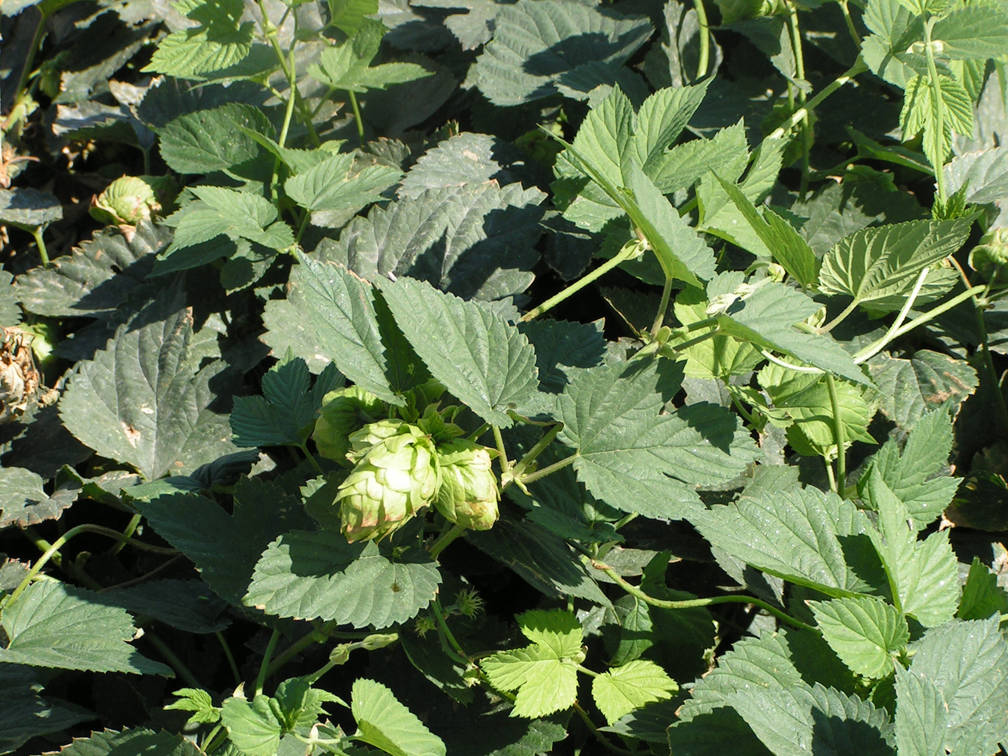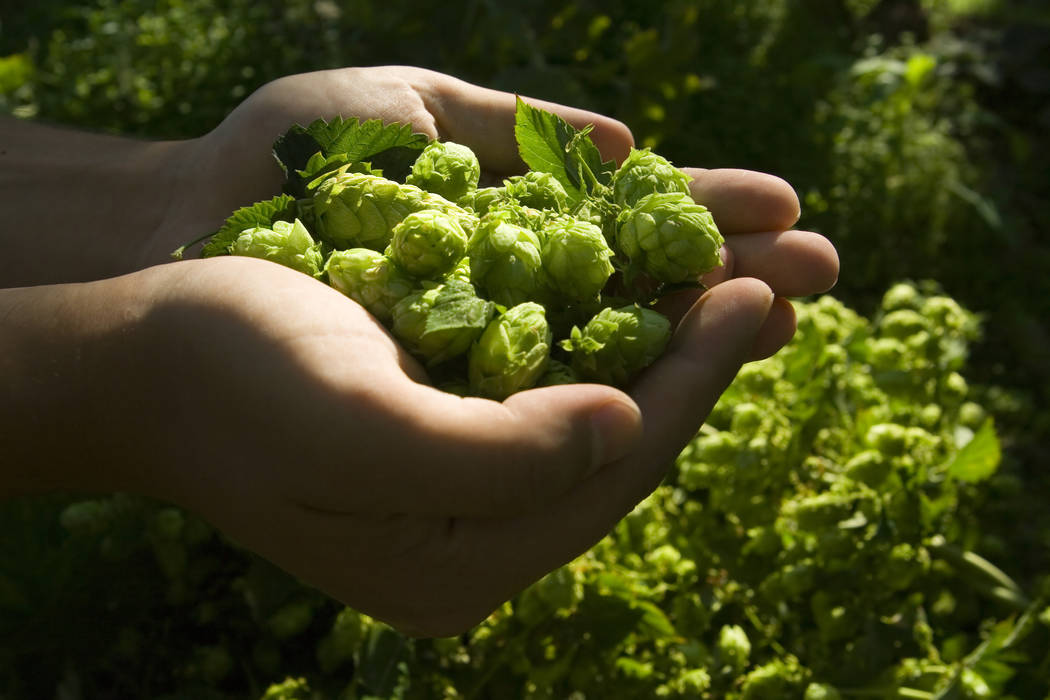Tap into growing hops
Hops. Even if you’re not a beer lover, you associate the word with brewing.
Since the 15th century, brewers have turned to hop flowers (also called “cones” or “strobili”) to add aroma and bitterness to beer’s base ingredients of barley, yeast and water. For beer purists, hops are the go-to when it comes to crafting a unique beer flavor. Depending on the variety, they can add a citrusy, spicy or sweet punch to any brew.
Part of the Cannabaceae family, which also includes cannabis, hops also make a great cup of tea, can be cooked like asparagus and are used by chefs to flavor dishes. Some even look to hops for their antibacterial properties in herbal medicines, but hops can also add a unique aesthetic to one’s backyard.
“I try to emphasize to people that it’s not all about brewing your own beer. … Hops are a real novelty, and they look pretty in the backyard,” said M.L. Robinson, an environmental horticulture specialist who oversees the University of Nevada Cooperative Extension Research Center and Demonstration Orchard in North Las Vegas.
For the past four years, Robinson and his research team have experimented with growing about 15 different hop varieties. They’ve learned that hops can grow quite well in the desert. Here, his team offers some tips for how to grow this unique plant in your backyard.
The hot and cold of it
Preferring moist, temperate climates, hops are commonly grown in Europe and in other four-season environments like the northern U.S. Their growing season starts in the spring and runs into the summer. Their cones are harvested between June and September, and each variety the Cooperative Extension experimented with typically produces about 12 pounds per season.
Cooperative Extension researchers say certain varieties grow well in the desert. Some that have done well include:
■ Cascade: One of the most popular hops used by brewers, with a medium-intensity, citrusy aroma.
■ Zeus: Suitable for pale ales, with a more pungent, black pepper or licorice aroma.
■ Nugget: Mild herbal aroma with a high bittering value in brewing.
■ Mt. Hood: Spicy, pungent aroma, typically grown in Oregon and used in U.S.-style and German-style lagers.
■ Galena: Often a late addition in brewing for those looking for intense citrus flavor and a sweet aroma.
■ Magnum: Apple and pepper aroma, a daughter of the Galena hop.
■ Chinook: A spicy hop with a distinct grapefruit aroma.
Keys to growing
Hop vines are actually called bines in botanical language. Bines are essentially vines that have hairs instead of tendrils.
Hop bines grow well along a natural organic rope, Robinson said. Some looking to enhance their backyard might want hops to grow along a trellis, but that move may produce inconsistent results. Organic rope still provides the best growing platform, and wherever you hang the rope, the hop vine will happily grow along it.
“You can put ropes up to the eaves of the house. The vines will shoot up to 20 feet,” Robinson said.
Hops also require about 15 hours a day of sunlight, which is where the give and take with the desert comes in. Yes, the desert easily provides that amount of sun, but the intensity of the direct sun can burn the plant, too. Cooperative Extension researchers have had to try different approaches.
If you’re looking to grow hops and want a sizable crop yield for brewing, Cooperative Extension researchers have seen their greatest success when using a hoop house with 30 percent shade covering. Other shade structures like greenhouses will work, too.
“We find those hops (in the hoop house) will sprout in the spring — a little sooner than the others,” Robinson said.
If you are planting your first vines, March is usually a good month, around the first sign of a warming trend. If you don’t have the space to create a hoop house, and maybe you want to simply add a vinelike aesthetic to the backyard, Robinson suggests an eastern exposure, where the direct sun primarily comes in the morning, and avoiding direct afternoon sun. Regardless of your motivation for growing hops, don’t expect many flowers in the first year, experts say, but by the third year, blooms should be plentiful.
“You’re not going to put anybody out of business with the number of hops you get,” Robinson added. “But it does make for a pretty conversation piece, too.”
Feeding the hops
Robinson also suggests amending the soil with compost and a quality organic soil. Hop plants do well in raised vegetable beds, too.
Hops also require considerable nitrogen, added Tamara Wynne, a UNR Cooperative Extension research associate. The team uses ammonium sulfate fertilizer at 21 percent nitrogen. Previously, Miracle-Gro was used, and with lower nitrogen levels, it required more fertilizing.
“Now, (using ammonium sulfate) we only need to fertilize a couple times during the growing season,” Wynne said.
The hops at the Cooperative Extension orchard are watered for 20 minutes, three times per week, using one 5-gallon per hour emitter per plant. Hops don’t require heavy watering — only about 60 percent of the water needed for alfalfa.
As the plant grows, it’s critical to pick the three best bines for each rope and cut away the rest, both Robinson and Wynne emphasized. This will assure you of the healthiest crop.
Watch for spider mites and aphids, which can suck the sap out of the plants. When found, however, these pests can easily be washed off with soapy water.
Southwestern variety, local brewer
For the past three months, Cooperative Extension researchers have been experimenting with a new hop variety — the Neomexicana — which is native to the Southwest and has grown well in Arizona, Texas and New Mexico. It has also been used in Sierra Nevada’s Harvest Wild Hop IPA.
Some of the research orchard’s hops have already been used by local brewery Tenaya Creek. Head brewer Anthony Gibson has used several pounds of hops each year from the Cooperative Extension to add aroma to some of Tenaya Creek’s versions of its 702 Pale Ale.
There isn’t enough hop volume being produced at the Cooperative Extension orchard to use the flowers during the boiling process, Gibson said. He drops the smaller amounts in mesh bags that he places inside the tank after the beer has already been boiled. The hops add a citrusy aroma.
Gibson also helps researchers evaluate the quality of the hops being grown on-site.
“This relationship has been fun for us. … We’ll also get different fruits from the orchard to use as well,” Gibson said. “We’re interested in trying the Neomexicana. I want to give it a shot, because we’ve never used that one before.”
With the Neomexicana being native to the Southwest, it may produce enough volume to be used on a commercial scale, according to Wynne.
“The plant does super well, and it’s looking very promising,” Wynne added.



























